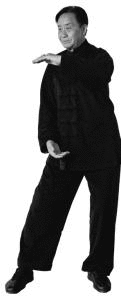🧘♂️ How to Use 下按功 and 抱球功 to Cultivate Internal Power
In Chen Style Taijiquan, 松胯 (sōng kuà) — the ability to relax the hips or groin area — is one of the most important internal skills a practitioner must develop. It allows energy to sink, improves rooting, and sets the foundation for powerful, fluid movement. (松sōng just means relax, and 转zhuǎn turn or rotate)
But 松胯 alone isn’t enough. It must be combined with 转胯 (zhuǎn kuà) — rotating the hips — to generate true internal power and silk reeling energy (缠丝劲 / chán sī jìn ).
In this article, we’ll explore:
- What is 松胯 and why it matters
- How to use 下按功 (Pressing Down) to train 松胯
- How to combine 松胯(Sōng Kuà) with 转胯 using 抱球功 (Embracing the Ball)
- The role of both in Chen Taijiquan practice
1. 🧠 What is 松胯 (Sōng Kuà)?
松胯 (sōng kuà) literally means “relaxing the hips.” In Taijiquan, it refers specifically to relaxing the inguinal region — the area where the legs connect to the torso, including the hip joints, lower back and inner thigh muscles.
松胯(sōng kuà) is not about collapsing or over-loosening the hips, but rather about releasing unnecessary tension while maintaining structural integrity. When you achieve 松胯(sōng kuà), your body becomes grounded, your movements smoother, and your energy flows more freely.
Why 松胯(Sōng Kuà) Matters:
- Improves rooting and stability
- Enhances energy flow (qi)
- Allows deeper stances without strain
- Prepares the body for effective 转胯 (hip rotation)
2. 📌 Using 下按功 (Xià Àn Gōng) – Pressing Down to Train 松胯(Sōng Kuà)
One of the best ways to begin cultivating 松胯(Sōng Kuà) is through the 下按功 (Xià Àn Gōng) — commonly known as “Pressing Down.”
This is one of the Eight Great Standing Qigong Movements (Ba Da Gong Fa) , and it’s perfect for beginners to feel the sensation of sinking the hips and relaxing the kua.
Explanation:
Start with hands palms up at your sides. Lift them slowly upward until they reach shoulder height, elbows dropping slightly inward toward the chest. As you inhale, your body gently lowers. Then, flip the palms downward and press them down as you exhale and rise up slightly. This creates an opposing stretch between upper and lower body , helping you cultivate awareness of energy sinking to the feet.
The posture ends in a neutral bow stance , emphasizing balance and grounding.
Health Benefits:
- Encourages internal energy circulation
- Promotes deep breathing and relaxation
- Helps transition from active motion to stillness (from Taiji to Wuji)
- Trains the coordination of breath, intent, and movement
3. 🔁 Combining 松胯(Sōng Kuà) with 转胯 (Zhuǎn Kuà) using 抱球功 (Bào Qiú Gōng)
Now that you’ve begun to understand 松胯(Sōng Kuà), let’s introduce 转胯(Zhuǎn Kuà) — rotating the hips .
While 松胯(Sōng Kuà) creates the conditions for free movement, 转胯(Sōng Kuà) brings dynamic action into play. Together, they form the core of Chen Taijiquan’s spiral power and efficient energy transfer.
Let’s look at 抱球功 (Embracing the Ball) — another of the Eight Great Standing Qigong Movements — as a practical way to integrate both principles.
- Stand with feet shoulder-width apart, knees slightly bent.
- Bring left hand above chest, palm facing down; right hand below abdomen, palm facing up — like holding a large ball between your arms.
- Keep shoulders relaxed, spine upright.
- Shift weight to the left, and rotate waist and hips to the left.
- Then reverse: shift weight to the right, rotate waist and hips to the right.
- Repeat this back-and-forth motion, coordinating arm movement with hip rotation.
Key Focus:
- Maintain 松胯(Sōng Kuà) throughout — keep hips soft and relaxed
- Let the hips drive the turn , not the shoulders nor the knees
- Coordinate weight shifting with hip rotation
- Breathe naturally — inhale when opening, exhale when closing
This exercise helps you feel how 松胯(Sōng Kuà) enables smooth 转胯(Zhuǎn Kuà), which then guides the upper body.
4. 💥 The Role of 松胯(Sōng Kuà) & 转胯(Zhuǎn Kuà) in Chen Taijiquan
Both 松胯 and 转胯 are essential for mastering the unique qualities of Chen Style Taijiquan:
| Skill | Benefit |
|---|---|
| 松胯 (Sōng Kuà) | Releases tension, improves grounding, enhances energy flow |
| 转胯 (Zhuǎn Kuà) | Generates power, enables smooth transitions, directs energy |
| Together | Create silk reeling energy (缠丝劲), unify the body, improve martial effectiveness |
These two concepts work together seamlessly:
- 松胯(Sōng Kuà) makes 转胯(Zhuǎn Kuà) possible
- 转胯(Zhuǎn Kuà) gives 松胯(Sōng Kuà) purpose
Without 松胯(Sōng Kuà), 转胯(Zhuǎn Kuà) becomes forced and rigid. Without 转胯(Zhuǎn Kuà), 松胯(Sōng Kuà) remains passive and unused.
🎯 Final Thoughts
Cultivating 松胯(Sōng Kuà) and 转胯(Zhuǎn Kuà) takes time, patience, and consistent practice. But once you begin to feel how these two principles work together, your Taijiquan will transform — becoming more rooted, powerful, and expressive.
The next time you practice 下按功 (Pressing Down) or 抱球功 (Embracing the Ball), take a moment to focus on the hips . Ask yourself:
Am I truly relaxing my kua? Can I feel the connection from my hands to my hips to my feet?
With mindful repetition, 松胯(Sōng Kuà) and 转胯(Zhuǎn Kuà) will become second nature — and so will the internal power of Chen Taijiquan.

